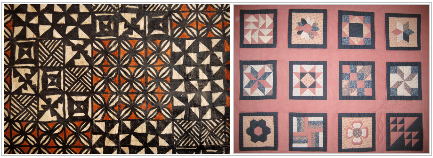Purpose:
You can help your child to use appropriate maths language to identify and describe some 2 dimensional shapes and their relative positions.
What you need:
- Fabrics like this that have designs featuring regular geometric shapes and patterns made with these shapes.
The shapes might be squares, triangles, oblongs (long rectangle), diamonds, (rhombus), hexagons (6 sides), circles, ovals (a symmetrical oval is called an ellipse) - Paper and card
- Coloured pencils or crayons
What to do:
If you know the (traditional) story of the fabric and its pattern, talk with your child about this.
Pose questions/problems such as:
Tell me about the shapes that you can see and where they are. (eg. “I can see a white triangle opposite a black triangle. They make a little square that’s inside a big square.”)
Tell me about little shapes that go together make bigger shapes.
Tell me about the black shapes you can see.
What’s the same about all of the squares you can see? (eg. “The four sides are the same and they’re straight, and the four corners look the same. They’re kind of square too.”)
Can you tell me about patterns that you can see (eg. There’s a white triangle, then a black triangle, then a white triangle, then a black triangle. They go along, but they also sort of turn round too.”)
Are there any shapes that are a bit like shapes you know? (eg. “The shape between the petals of the (frangipani) flower on tapa cloth, looks a bit like a triangle, but it’s not because its sides aren’t straight.”)
Suggest they might like to make a patterned card or banner for a special person or occasion,
Have your child point out and talk about a favourite part of a pattern and tell you what they notice. Ask them to draw (copy) this on paper. (Have them pay attention to and talk about the features of the shapes as they draw, but don’t insist on absolute precision.)
Suggest they make their own repeating pattern on the card or paper with some of the shapes they can see.
What to expect your child to do:
-
Easier
Know some shape and positional language and also learn new language during the activity.
Talk about the number of sides and corners of shapes and recognize similarities and differences between shapes.
Make approximate representations of the shapes. -
Medium
know all the shape, positional and mathematical language and draw with attention to detail and greater precision.
He Kupu Māori:
| square | tapawhā rite |
| triangle | tapatoru |
| rectangle | tapawhā hāngai |
| diamond | taipan |
| hexagon | tapaono |
| oval | porohema |
| side | tapa |
| corner | kokonga |
| pattern | tauira |
| flip | kauhuri |
| slide | nene |
| turn | huri |
Download a file of this activity:
PDF (377KB)
